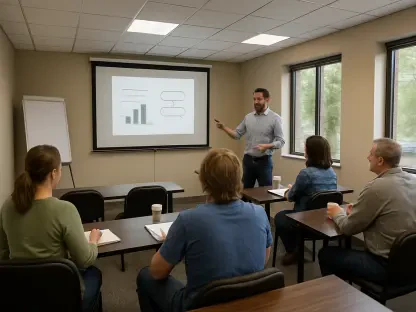Imagine a world where the potential of college students to become trailblazing entrepreneurs and innovators isn’t left to guesswork or outdated evaluation tools, but is instead predicted with remarkable accuracy through cutting-edge technology. This compelling vision drives a transformative study by Dai and Li, published in Discover Artificial Intelligence. Their research unveils a deep learning model specifically crafted to assess and forecast students’ capabilities in innovation and entrepreneurship, presenting a revolutionary approach for higher education institutions striving to prepare the next wave of leaders for a competitive global landscape. Unlike traditional methods that often fall short by focusing solely on academic metrics, this model digs deeper, capturing the essence of what truly defines entrepreneurial success. It’s a shift that promises to redefine how talent is identified and nurtured, ensuring that vital skills like creativity and problem-solving are no longer overlooked in the educational journey.
Transforming How Talent Is Identified
Beyond Grades and Standard Tests
Traditional assessment methods in higher education have long been criticized for their narrow focus on grades and standardized test results, often missing the broader spectrum of skills that define entrepreneurial potential. These conventional tools tend to prioritize rote learning and academic achievements over critical attributes such as innovative thinking, adaptability, and the courage to take calculated risks. The study by Dai and Li highlights this significant gap, pointing out that many students with exceptional creative or leadership qualities are undervalued because their strengths don’t fit into a typical academic mold. By relying on subjective evaluations or outdated metrics, institutions risk overlooking individuals who could become transformative figures in the business world. This research advocates for a more comprehensive framework, one that values the diverse traits necessary for success in dynamic, real-world environments, pushing educators to rethink how potential is measured and supported.
A New Era with Advanced Algorithms
Deep learning technology introduces a groundbreaking way to uncover and predict student potential, moving far beyond the limitations of traditional assessments. Utilizing sophisticated neural network architectures, this model processes vast and varied datasets—ranging from behavioral patterns to extracurricular involvement—to detect subtle indicators of entrepreneurial aptitude. Unlike older methods that rely heavily on static data like test scores, this approach identifies correlations and trends that might otherwise go unnoticed, offering a more nuanced understanding of a student’s capabilities. The result is a predictive tool that not only evaluates current skills but also forecasts future success in innovation-driven fields. For educators, this means having access to insights that can guide early interventions, ensuring that high-potential students receive the support they need to flourish in competitive arenas long before they enter the workforce.
Customizing Education for Maximum Impact
Flexibility for Varied Academic Settings
One of the most impressive aspects of the deep learning model is its adaptability to different educational contexts, ensuring that it remains relevant across a wide range of institutions. Whether applied in a sprawling public university with thousands of students or a specialized private college with a niche focus, the algorithms can be tailored to account for unique demographics, curricula, and institutional goals. This flexibility addresses a critical challenge in higher education: the diversity of student populations and learning environments. By customizing the model to fit specific needs, it becomes a versatile asset that can help schools worldwide enhance their approach to fostering entrepreneurial talent. Such adaptability ensures that the technology isn’t just a luxury for well-funded institutions but a practical solution for any educational setting aiming to prepare students for leadership roles in an ever-evolving economic landscape.
Practical Strategies for Skill Development
Beyond merely identifying potential, the deep learning model offers actionable recommendations that empower educators to make meaningful changes in their teaching strategies and curricula. When the system detects deficiencies in key areas—such as a lack of risk-taking ability or creative problem-solving—it suggests targeted interventions like workshops, mentorship programs, or project-based learning opportunities to address those gaps. This proactive stance enables institutions to cultivate an entrepreneurial mindset well before students graduate, equipping them with essential tools for success in the professional world. Moreover, these insights allow for personalized educational experiences, ensuring that each student receives support tailored to their unique strengths and weaknesses. By integrating such data-driven guidance, colleges can transform their programs to better align with the demands of modern industries, ultimately producing graduates who are not just job-ready but innovation-ready.
Overcoming Obstacles in Implementation
Safeguarding Privacy and Fairness
While the promise of deep learning in education is undeniable, the research candidly acknowledges significant challenges that must be addressed for responsible deployment. Data privacy stands out as a paramount concern, as the model relies on extensive personal information to generate accurate predictions, raising questions about how to protect student data from misuse or breaches. Equally important is the risk of algorithmic bias, which could inadvertently favor certain groups over others if not carefully monitored. Dai and Li stress the importance of transparency in the model’s design and implementation, advocating for regular ethical audits to ensure fairness across diverse student populations. Addressing these issues isn’t just a technical necessity but a moral imperative, as the goal is to create an equitable system that benefits all students without introducing unintended disparities or compromising trust in educational technology.
Bridging Academia and Industry Demands
Another critical dimension of this research is its focus on aligning educational outcomes with the evolving needs of the job market, creating a seamless connection between academic preparation and professional success. By leveraging deep learning to predict and enhance entrepreneurial skills, colleges can better equip students to meet real-world challenges, from launching startups to driving innovation within established organizations. This synergy between academia and industry holds the potential to fuel economic growth by producing a workforce that is adept at tackling complex problems with fresh perspectives. The model serves as a bridge, helping educators understand which skills are most valued in today’s dynamic markets and adjusting their programs accordingly. Such alignment not only benefits students by increasing their employability but also strengthens the broader economy by ensuring a steady pipeline of capable, forward-thinking leaders ready to innovate.
Shaping the Future of Educational Innovation
Reflecting on a Groundbreaking Approach
Looking back, the study by Dai and Li marked a pivotal moment in redefining how entrepreneurial potential was assessed and nurtured in higher education. Their deep learning model stood out as a powerful alternative to outdated evaluation methods, providing a comprehensive, data-driven perspective on student capabilities that traditional tools simply couldn’t match. Its ability to predict future success and offer tailored recommendations reshaped the way institutions approached talent development, focusing on holistic growth over narrow academic metrics. Despite the ethical and technical challenges that surfaced, the commitment to transparency and fairness paved the way for trust in this innovative system. This research laid a strong foundation for a new era in education, one where technology played a central role in unlocking the hidden potential of countless students, preparing them to lead in an increasingly complex world.
Paving the Way for Broader Impact
As the educational landscape continues to evolve, the next steps involve scaling this deep learning approach to reach more institutions and refining its algorithms to address emerging needs. Collaboration between technologists, educators, and policymakers will be essential to ensure that the model remains adaptable and inclusive, tackling issues like data security with robust solutions. Exploring partnerships with industry leaders can further enhance the alignment of academic training with market demands, creating a feedback loop that benefits all stakeholders. Additionally, investing in training for educators to effectively use these tools will maximize their impact, turning predictive insights into tangible outcomes. By embracing these strategies, higher education can build on the pioneering work of Dai and Li, fostering a generation of innovators equipped to drive progress and solve global challenges with creativity and resilience.








